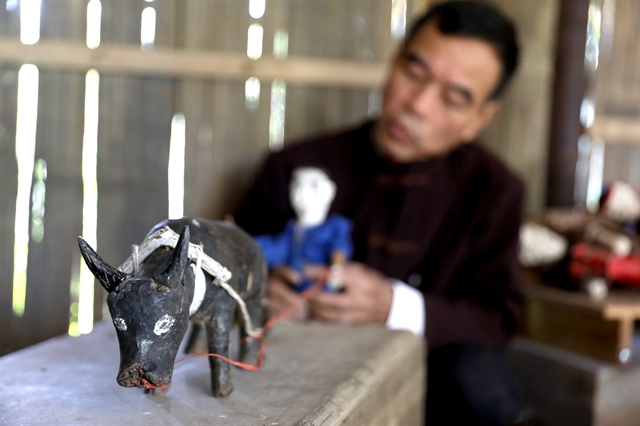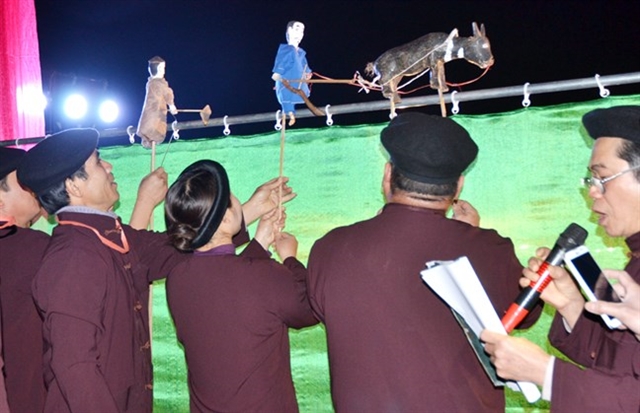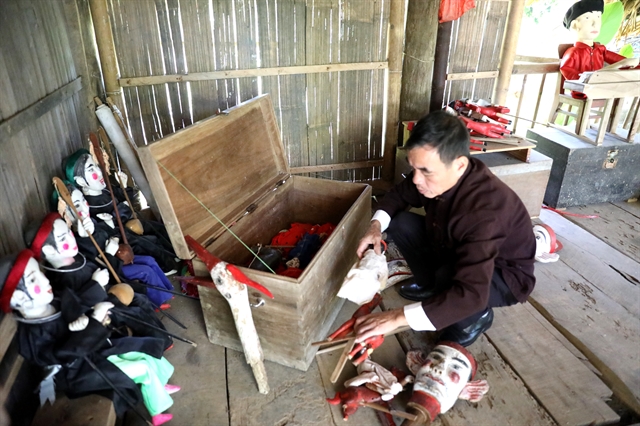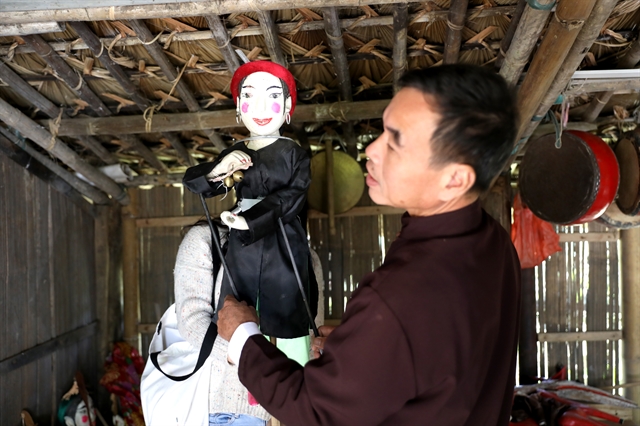
Puppeteer Ma Quang Nhanh is pictured with puppets of a farmer and a buffalo. VNS Photo Đoàn Tùng
By Lương Thu Hương
With its daily life deeply entwined with agriculture, the Tày ethnic community in the northern province of Thái Nguyên has come up with unique traditional art forms. Perhaps the most renowned is stick puppetry.
Stick puppetry is often performed by the Tày people on traditional holidays, the Lunar New Year, as well as on the first and fifteenth day of each lunar month, particularly in the Lồng Tồng festival, a ceremony to pray for good weather and a bumper harvest.
Through the puppet performances, spirits and ancestors are believed to bless and protect the village.
The puppet shows also depict the stories of the community, celebrating their achievements and history. Each puppet stage serves as a cultural space where the community can relax and find joy in life after days of hard work, while showcasing the profound cultural identity of the Tày ethnic group.

The puppet performances express the desire for favourable weather, abundant harvests, and peacefulness. Photo mattran.org.vn
The stick puppetry of the Tày is preserved in a number of villages in Thái Nguyên, but the most popular is in Thẩm Rộc Hamlet in Bình Yên Commune. According to the local elders, the art has existed there for over two hundred years and is still upheld and passed down by the Ma Quang clan.
“Stick puppetry in the hamlet has a long history spanning several hundreds of years,” said Ma Quang Nhanh, a senior puppeteer, adding that he is one of the 14th generation practising the art form.
According to Nhanh, stick puppetry underwent a decline during the two resistance wars as many local puppeteers went to the battle, and the locals had no time for entertainment. But in 2000 it underwent something of a renaissance and has been maintained until today.

Some of Thẩm Rộc puppets might be up to 200 years old. — VNS Photo Đoàn Tùng
Initially, the puppet set consisted of only six puppets, including two large ones representing the father, with a red face, and the mother with a white face. Over time, the set has increased to 12 pieces, and now there are up to 30 in a typical show.
The human-shaped puppets in Thẩm Rộc are often seen from the waist upward and there are normally no legs. Some others are made from a single block such as a buffalo puppet, but the majority have parts and details assembled with joints or strings, allowing easy movement and manipulation.
Most Thẩm Rộc puppets are made from a type of soft, lightweight wood that is easy to work with and manipulate. It is also less prone to termite damage and can be preserved for a long time compared to other woods.
As per the customs of the Tày community in Thẩm Rộc Hamlet, the century-old stick puppets that have been passed down from their ancestors can only be preserved by the clan leader.

Red puppet symbolises the father and the white one the mother. — VNS Photo Đoàn Tùng
The Tày people attach a significant spiritual role to the puppets. When a new puppet is made, or before and after each performance the clan leader must prepare offerings including porridge, cakes, fruits, and incense to pay tribute to the ancestral craft and puppet deities.
“On the day of performance, these puppets must also be carried along, as we believe that they must ‘share the good fortune’ with us,” said Nhanh, who is now preserving the ancient puppets.

Only the clan leader is authorised to preserve the ancient puppets. — VNS Photo Đoàn Tùng
Even when the clan leader wants to open the box containing the puppets, he must ask for permission from the ancestors and puppet deities.
Due to their spiritual importance and degraded conditions due to weather, the ancient puppets are not used for performances, and newly made ones are used instead.
To adapt to the new context, the local puppeteers have come up with new characters such as an MC or musicians playing the đàn bầu (monochord) or đàn tính (gourd lute).
According to Nhanh, there are 16 puppet show scripts recorded in ancient books; however, only three to five of them are performable, as for some their content has become unsuitable. Others have been adapted to the modern day.
The equipment for the stick puppet performance is basic. It typically involves a stretched backdrop as the stage, along with musical instruments such as the gourd lute and flute, accompanied by the recitation of the script and the skilful hands of the puppeteers.
Each script is performed for up to 10 minutes but involves the manipulation of up to 15 people at a time.

To keep up with modern context, the puppeteers have created new characters. — VNS Photo Đoàn Tùng
Preservation
Thẩm Rộc puppetry is a distinctive art form that vividly portrays everyday life and the aspirations of the Tày people.
In 2015, it was recognised as a national intangible cultural heritage by the Ministry of Culture, Sports and Tourism. However, due to various changes and challenges, it has gradually faded away and is at risk of being lost.
One of the difficulties is the limited capability and artistic creativity of the puppeteers in creating new puppets or writing new scripts, according to Nhanh.
“We haven’t been through any formal training, so we have to rely on our own hands and a bit of improvisation,” he said.
Additionally, all the most talented and passionate puppetry artists are ageing, while the local younger generations are mostly working far away or lack interest in this art genre, said Hoàng Yến, cultural official of the People's Committee of Bình Yên Commune.
Another difficulty is a shortage of financing. Many local puppeteers are unable to solely rely on the profession for a living and often engage in other occupations.
With the efforts to preserve their ancestors’ heritage, the Ma Quang clan in Thẩm Rộc has established a puppetry troupe operated on voluntary spirit, not driven by economic purposes.
Stick puppetry has also been integrated into the extracurricular programmes in schools in Thái Nguyên Province by local authorities.

A class teaching Thẩm Rộc stick puppetry has been opened, primarily targeting young learners. Photo courtesy of the People's Committee of Bình Yên Commune.
Recently, with the support of the Vietnam Museum of Ethnology, a one-week class teaching Thẩm Rộc puppetry has opened, primarily targeting younger learners.
“The existence of the art form depends on every individual in our clan, and its effective preservation needs the joint efforts of the community and the local authorities. Stick puppetry will endure for as long as our clan exists,” Nhanh said. VNS
OVietnam